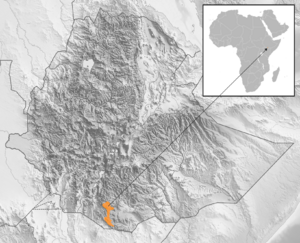Stresemann's bushcrow facts for kids
Quick facts for kids Stresemann's bushcrow |
|
|---|---|
 |
|
| A Stresemann's bushcrow at Yabello Wildlife Sanctuary, Ethiopia | |
| Conservation status | |
| Scientific classification | |
| Genus: |
Zavattariornis
|
| Species: |
stresemanni
|
 |
|
| Where the bushcrow lives | |
The Stresemann's bushcrow (Zavattariornis stresemanni) is a special bird that looks a bit like a starling but is actually part of the crow family, called Corvidae. It's also known as the Abyssinian pie or Ethiopian bushcrow. This bird is a bit bigger than a North American blue jay. It has a bluish-grey body that turns almost white on its forehead. Its throat and chest are a creamy-white, and its tail and wings are shiny black.
The bushcrow has brown eyes surrounded by a bright blue patch of skin that has no feathers. Its beak, legs, and feet are black. These birds usually eat insects and often feed in small groups. They build their nests high up in acacia trees, usually starting in March. A nest often holds five or six creamy eggs with purple spots. The nest itself is round with a tube-like entrance at the top. Sometimes, other bushcrows, perhaps older siblings, help the parents raise the young.
This bird lives in a very small area of southern Ethiopia, in places like Yavello, Mega, and Arero. It needs a specific, slightly cooler temperature to find food properly. This makes it very sensitive to climate change. Scientists believe it's one of the birds most at risk from a changing climate, with its numbers possibly dropping a lot in the future.
Contents
About the Stresemann's Bushcrow
The Stresemann's bushcrow was first officially described in 1938 by an Italian bird expert named Edgardo Moltoni. For a long time, scientists weren't sure which bird family it belonged to. It has some unusual features, like its bare facial skin that can move.
Even though it looks a bit like a starling, DNA tests show that it is indeed part of the crow family, Corvidae. Its closest relatives are the ground jays and the piapiac. Some experts think the bushcrow might be a very old relative that survived from a long time ago.
This bird has many common names. People call it Stresemann's bushcrow, bush-crow, Ethiopian bushcrow, Abyssinian bushcrow, or simply Zavattariornis. The name Zavattariornis honors Edoardo Zavattari, an Italian zoologist. The name Stresemann honors Erwin Stresemann, a German bird expert.
What Does it Look Like?
The Stresemann's bushcrow is about 28 centimeters (11 inches) long and weighs around 130 grams (4.6 ounces). Male and female bushcrows look very similar. They are mostly pale grey with a black tail and wings. Their head, back, and upper tail feathers are all pale grey. The feathers on their forehead and throat fade into white.
The bright blue skin around the bushcrow's eye has no feathers. This skin can puff up, making the bird's dark brown eye look like a narrow slit. The feathers behind the eye can move to show a pink patch of skin. The bird's black beak is curved and pointed, and it's quite small for a crow. Its legs are black. Young bushcrows are a bit duller in color than adults.
Bushcrow Sounds
The bushcrow is a very noisy bird, especially when it's looking for food. Its main call sounds like a metallic "kej." When flying, it often makes a fast, nasal "kerr kerr kerr" sound. They also make other noises. Adults preening each other might say "kaw, kaw, kaw." Birds looking for food make sounds like "how, how, how," a quiet "quak," or a soft, repeated "guw."
Where Do Bushcrows Live?
This bird lives only in central-southern Ethiopia. It can be found in a small area around the towns of Yabelo, Borena, Mega, and Arero in Sidamo Province. It also lives in protected areas like Yabelo Wildlife Sanctuary and Borana National Park. Its total home area is about 2,400 square kilometers (930 square miles).
The Stresemann's bushcrow lives in flat savannas. These areas have mature acacia and Commiphora thornbushes. The bird likes open savannas with short grass and scattered groups of these thornbushes. The soil needs to be deep and rich for the bushcrow to live there. They are most common when these bush areas are next to farm fields.
For many years, no one knew why the bird was missing from some areas that looked like good homes for them. But new research shows that the bird needs a very specific average temperature. Areas that seem suitable but are not inhabited are actually a tiny bit warmer, which stops the birds from living there. Their habitat is usually between 1,300 and 1,800 meters (4,300 and 5,900 feet) above sea level.
Bushcrow Behavior and Diet
Stresemann's bushcrows are usually found in groups of about six birds. They do not migrate, meaning they stay in the same area all year.
What Do Bushcrows Eat?
Bushcrows look for food both on the ground and in trees. They start searching for food at sunrise. A bushcrow might hunt alone, with a partner, or in a group of six or seven other bushcrows. When looking for food, a bushcrow digs strongly in the soil with its beak slightly open to catch any insects it finds. When it catches something, it takes it to a nearby tree or bush, holds it down with its foot, and then eats it.
They also use their beaks to pull apart rotten wood and check cow dung for food. Sometimes, they even land on the backs of cattle to look for bugs. They can chase flying insects on foot, changing direction quickly and leaping to catch their prey. They often hunt alongside other birds like white-crowned starlings and red-billed hornbills. When hunting in trees, they can walk on horizontal branches and jump up towards the treetop. Then they glide down from the top to the ground.
Bushcrows mainly eat invertebrates, especially insects like termites. They also eat larvae and pupae (young stages) of moths and beetles, as well as adult insects.
Reproduction and Life Cycle
Stresemann's bushcrows nest alone or in small groups of three to five nests that are loosely connected. They are monogamous, meaning they usually stay with the same partner for life. Sometimes, a third bird, or even two to four more, will help the breeding pair build the nest and care for the young. These helpers might even help at more than one nest in the colony. The birds feed and preen each other, both within the pair and with other bushcrows in the colony.
The bushcrow lays its eggs soon after the first rains, which usually happen in late February and early March. This means their eggs are laid in late March and early April.
The nest is a messy, round shape. The roof tapers to a point with an opening into the inside chamber. The nest is about 60 centimeters (24 inches) wide, and the inside chamber is about 30 centimeters (12 inches) across. To start building, a single twig is placed at the top of an acacia tree, about 5 to 6 meters (16 to 20 feet) above the ground. This makes the pair of bushcrows excited, and their blue facial skin puffs up. They then pick acacia leaves and twigs, dropping them to the ground. After this, they chase each other through the trees before continuing to build. The nest is made of thorny twigs, and the inside is lined with dry grass and dried cow dung. Damp soil helps hold the first twigs together. Old nests are often fixed up and used again.
Up to six eggs are laid in the nest. The bushcrow's eggs are cream-colored with pale lilac spots. These spots are usually more concentrated in a ring at the wider end of the egg.
Bushcrows and People
In the past, the nomadic people of Ethiopia moved their cattle around. This left loose, dung-covered soil, which was a great hunting ground for the bushcrow. It provided lots of beetle larvae for them to eat.
Conservation Efforts
Changes in how people graze their cattle in Ethiopia have hurt the Stresemann's bushcrow. People are now settling in permanent villages. This new lifestyle has led to too much grazing and hard, packed soil in some areas. This means less food for the bushcrow. Also, the idea of private land ownership has led to more farming of crops like maize. The rich soil the bushcrow needs for foraging is also good for farming.
In the Yabello Wildlife Sanctuary, acacia trees are being cut down for firewood. This removes the places where bushcrows build their nests. Even though the sanctuary is protected by law, it's hard to enforce these rules. It's thought that between 1999 and 2003, the bushcrow population dropped by 80%.
The IUCN Red List of Threatened Species lists the Stresemann's bushcrow as endangered. This is because it lives in a very small area and is losing its habitat. Its population seems to be shrinking quickly. In 2007, it was estimated that fewer than 10,000 birds might be left.
Climate Change Threat
Because of its very specific temperature needs, the Stresemann's bushcrow is considered one of the birds most threatened by climate change. Scientists predict that climate change could reduce its home range by 90% by the year 2070, even in the best-case scenarios. This greatly increases the risk of the bird becoming extinct in the wild. A similar problem is predicted for the white-tailed swallow (Hirundo megaensis), which lives in the same area and likely needs similar conditions.
Both of these birds might be the only warm-blooded animals whose living areas are completely controlled by the climate. Strong conservation efforts, like captive breeding (raising them in zoos) and assisted migration (moving them to new suitable areas), might be needed to save the Stresemann's bushcrow. These birds and their predicted decline can also be used as indicator species for climate change. This means they can help scientists test how well habitat models work for other threatened animals. They can also serve as flagship species to show the effects of climate change on birds in Africa.


